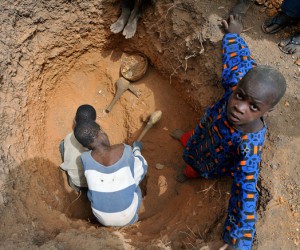In many African countries, a new mine starting up will often find artisanal miners in their area and even on its concession, and it needs to deal carefully with this issue to ensure the long-term sustainability of its operation.
According to development consultant Jules Mulya, who is based in the Democratic Republic of Congo working with mining companies and other stakeholders, it is vital for every mine to be sensitive to its social and economic environment.
Mulya said the question of artisanal mining was not easy to solve, as many of these miners are driven to this work by unemployment and poverty. They will often use manual methods – even just a pick and shovel – to mine in areas where they seldom have the legal right or permits to do so.
But, whether legal or not, artisanal mining is a reality of the African minerals landscape, said Mulya, and needs to be handled carefully and professionally.
“Working on remote sites under difficult conditions and hidden from the public eye, there are many thousands of artisanal miners who face exploitation,” he said. The profits they generate, for instance, often go to armed groups, traditional authorities or corrupt government officials.
Both mining companies and governments have an obligation to deal with the community aspirations for employment and a better life, especially where artisanal mining is the only option for earning a livelihood. He said that some governments have set up agencies to support artisanal miners, although weak governance can compromise how well these agencies work.
As a practitioner in this complex field, Mulya’s job is not easy. There are plenty of ‘grey areas’ in which a simple, legal approach is not sufficient to deal with the competing interests at play.
Mulya sharpens his professional skills through continuous learning, and recently completed a course on community development and stakeholder relations presented by Synergy Global and the Centre for Sustainability in Mining and Industry at Wits University.
“The course taught me a lot about the importance of engaging everyone,” he said. “Even though artisanal miners are often regarded as an obstacle to industrial mining, the large companies have to engage them and establish a relationship based on trust. Companies usually have the law on their side but this is not enough. The ultimate objective is to obtain a social licence to operate, as this is the basis for a successful, long-term project; it is critical that important stakeholders such as artisanal miners are not ignored or dismissed.”
There are four Synergy/CSMI courses, each running for five days that make up the Certificate Programme in Community Relations Practice in the Extractive Industry – all aimed at building the capacity of community relations practitioners.
Mulya believes in the power of mining to change lives for the better by bringing development to disadvantaged regions.
“When it is done correctly, mining brings infrastructure such as energy generation, roads and social amenities, which make life better for communities and also provide business opportunities for local entrepreneurs,” he said. “So it is important that mining projects align their vision with local and national government priorities to ensure that they have the best impact possible.
“In Katanga province of the DRC, for instance, mining companies focused their social investment initiatives on farming to reduce food shortages that were the cause of many social problems like school dropouts, petty theft and disease. This was done in response to recommendations made by the provincial government. Since then we've seen milling companies being set up, providing jobs and business opportunities to the unemployed.”
Mines are often pioneer ventures, establishing themselves in areas before there are even basic services like water or electricity. In these conditions, said Mulya, the norm was often to create islands of development with little impact except for the jobs on site; this is no longer the case, as communities and governments look for the benefits of mining to be spread and integrated with other economic growth initiatives.
Mines now see the need for early and ongoing engagement with local communities, to make sure that decisions made are in the broader social and economic interest. While investors expect a return on their mineral investment that is in line with their risk, they also must recognise the roles of local players in the success of the venture.
“What is new is how companies go about investing in communities,” he said. “Even in the DRC, a major paradigm shift has taken place; the notions of sustainability, shared value and engagement based on mutual respect have come to the fore.”
He has seen the change in communities’ vision, too, as they start to look to the longer-term future and not just immediate gains from the fruits of mining.
“Communities no longer only aspire to improved livelihoods for now,” said Mulya. “They have started to take a long term view, thinking of their own future and future generations. They know that the mining resource in their land will one day be depleted so they want to be ready for it; this also helps companies become more fully aware of their post-mining obligations.”
Exclusive CSMI release






